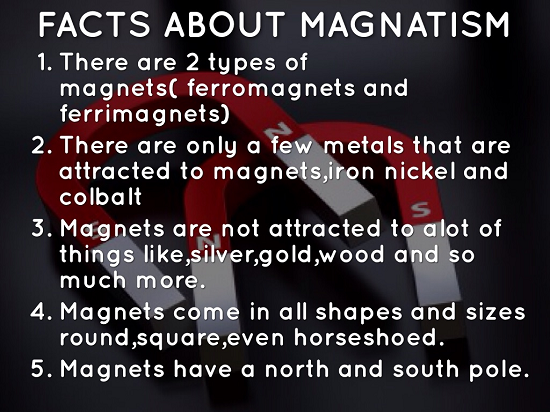Unit 16: Magnetism
Unit 16: Magnetism

Unit 16: Magnetism

Unit 16: Magnetism
Science is our understanding of how the world works—and generally the world works fine whether we understand it or not. Take magnetism, for example. People have known about magnets for thousands of years and they've been using them practically, as compasses, for almost as long. The ancient Greeks and Romans knew as well as we do that lodestone (an iron-rich mineral) can attract other pieces of iron, while the ancient Chinese were making magnetic compasses set in intricate wooden inlays for their practice of Feng Shui (the art of carefully arranging a room) thousands of years before interior designers came on board. Science can sometimes be slow to catch up: we've only really learned how magnetism works in the last century, since the world inside atoms was first discovered and explored.
What is magnetism?
Playing with magnets is one of the first bits of science most children discover. That's because magnets are easy to use, safe, and fun. They're also quite surprising. Remember when you first discovered that two magnets could snap together and stick like glue? Remember the force when you held two magnets close and felt them either attract (pull toward one another) or repel (push away)? One of the most amazing things about magnets is the way they can attract other magnets (or other magnetic materials) 'at a distance,' invisibly, through what we call a magnetic field.
To ancient people, magnetism must have seemed like magic. Thousands of years down the line, we understand what happens inside magnetic materials, how their atomic structure causes their magnetic properties, and how electricity and magnetism are really just two sides of the same coin: electromagnetism. Once scientists would have said magnetism was the strange, invisible force of attraction between certain materials; today, we're more likely to define it as a force created by electric currents (themselves caused by moving electrons).
Almost everyone knows these six basic facts about how magnets behave:
- A magnet has two ends called poles, one of which is called a north pole or north-seeking pole, while the other is called a south pole or south-seeking pole.
- The north pole of one magnet attracts the south pole of a second magnet, while the north pole of one magnet repels the other magnet's north pole. So we have the common saying: like poles repel, unlike poles attract.
- A magnet creates an invisible area of magnetism all around it called a magnetic field.
- The north pole of a magnet points roughly toward Earth's north pole and vice-versa. That's because Earth itself contains magnetic materials and behaves like a gigantic magnet.
- If you cut a bar magnet in half, it's a bit like cutting an earthworm in half! You get two brand new, smaller magnets, each with its own north and south pole. (This is, of course, a joke. You don't get two worms if you cut a worm in half. But you do get two magnets.)
- If you run a magnet a few times over an unmagnetized piece of a magnetic material (such as an iron nail), you can convert it into a magnet as well. This is called magnetization.
What is a magnetic field?
Magnetic fields visualized with computer graphics
Department of Energy.
Suppose you put a bar magnet (shaped like a rectangle, sometimes with the north and south poles painted different colors) or a horseshoe magnet (bent round into a tight U-shape) onto a table and place an iron nail nearby. If you push the magnet slowly toward the nail, there will come a point when the nail jumps across and sticks to the magnet. That's what we mean by magnets having an invisible magnetic field that extends all around them. Another way of describing this is to say that a magnet can 'act at a distance': it can cause a pushing or pulling force on other objects it isn't actually touching).
Magnetic fields can penetrate through all kinds of materials, not just air. You probably have little notes stuck to the door of your refrigerator with brightly colored magnets—so you can see that magnetic fields cut through paper. You may have done the trick where you use a magnet to pick up a long chain of paperclips, with each clip magnetizing the next one along. That little experiment tells us that a magnetic field can penetrate through magnetic materials such as iron.
Vocabulary
Lesson Reading

